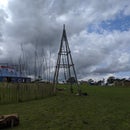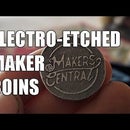Introduction: Tiny Wooden Laptop
I was at MakersCentral in England recently and visited the @pimoroni stall and picked up a 4" touchscreen for a Raspberry pi called the HyperPixel 4.0. It's an 800x480px 4" multi-touch screen.
Thinking about a project to use it in quickly turned into this wooden laptop with a copper inlay,
Step 1: Glue Up Panels
The first thing I needed to do was to glue up a panel that I could then cut both the top, bottom and front edges of the box from.
This was as easy as cutting down some strip wood and gluing them together as the edges came square from the supplier.
I used tape to clamp them and then sanded them smooth.
Step 2: Copper Inlay
Next I cut the panel in two and took the piece that will become the lid of the laptop and marked out a design in pencil.
Next I took a small flat carving chisel and a hammer and following the design, cut about 5mm into the wood, gently spreading the slot apart in order to fit the copper.
Once the the whole design was slotted, I cut some pieces of flat copper strip down to the correct size and, applying CA glue, hammered them into place.
I added some CA kicker and left it to dry before sanding the top smooth.
Step 3: Assembling the Box
I glued the front edges onto the top and bottom pieces and lined up some more strip wood to mark for the sides.
As you will see in the following steps, the 3d printed hinge mechanism requires an 8-10mm hole in the sides to open evenly. To achieve this, before cutting out the sides I used a 10mm drill bit to drill a hole at the very corner of each side.
I then cut the sides down on the bandsaw, glued everything together and once dry trimmed it all with the tablesaw.
Step 4: Finishing the Box
Using my makeshift router table, I chamferred all of the external edges of the box.
After a little more sanding I then finished all the wood with Teak Oil.
Step 5: Install Power Socket and Switch
I drilled a hole in each side of the bottom section and added a power switch and socket.
Step 6: 3D Printed Parts
Using Fusion360 I designed the hinge mechanism. This was based on the dimensions of the box and designed to open and close keeping the top and bottom sections aligned and allowing them to open up to a comfortable angle.
Next I designed face plates to surround the screen and keyboard.
Step 7: Final Assembly
Using CA glue I attached the outer hinge mechanisms to the top section of the box.
Next I assembled the components:
- A raspberry pi 3
- A UPS Hat (uninterruptible power supply)
- The HyperPixel screen
The UPS Hat has a 2200mah lipo battery and charging circuit which will allow me to switch from mains to battery seamlessly.
This was attached to the power button and then to the power socked via a re-purposed Micro USB lead.
The keyboard is a very small Bluetooth keyboard which has its own battery, however as I didn't want to make the keyboard removable, I also attached it to one of the raspberry pi's USB ports so that it always had power.
After that I glued the bottom section to the hinge mechanisms and glued the top and bottom hinge covers on completing the project.
All that was left was to fire it up and play some good old fashioned retro point and click games, in this case Beneath a Steel Sky...
Thanks for reading,
Kieran






